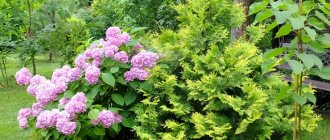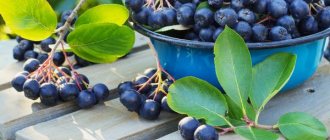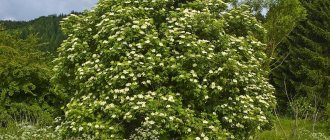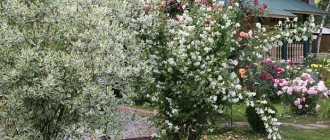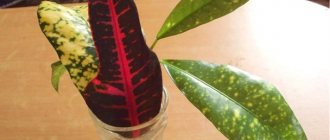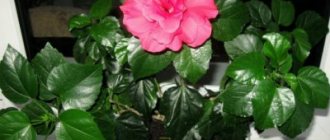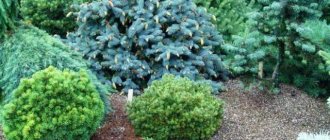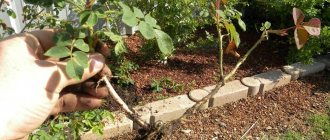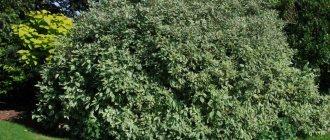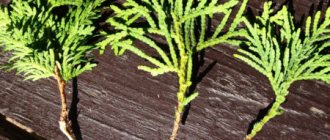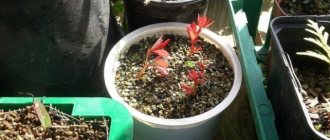Blue spruce in nature and in selection
The homeland of the beautiful spruce is North America. There it is common in the mountainous regions of the west and southwest and is a symbol of two states: Utah and Idaho. Under natural conditions it grows up to 40 m tall and can reach an age of several centuries. The crown of young trees is in the shape of a narrow cone, while that of older trees is cylindrical. The needles are green with a bluish-blue coating. Ripe cones are light brown, about 4 cm in diameter when opened. In the north of Russia, forms of spruce with blue needles are also found. The wax coating protects the branches from excessive fumes and harmful atmospheric substances.
Attention! The definition of “blue spruce” speaks only of color, and not of membership in the species. The species “blue spruce” does not exist; blue color is found in common spruce, prickly spruce, Canadian, and Siberian spruce.
Decorative varieties with blue needles:
- Waldbrunn (gray-blue pyramidal crown, about a meter high).
Waldbrun
- Montgomery (bright blue flattened crown, height 2 m).
- Blue Pearl (dwarf tree with bright green-blue needles).
Blue Pearl
- Blue fog (dwarf variety, deep blue needles).
- Glauka Globoza (dwarf variety with silver-blue needles).
- Canadian blue (dwarf variety with fast growth, bluish needles).
Description of the method: propagation by cuttings
It is necessary to start propagating the blue beauty using cuttings from their preparation. Trees of blue, bluish and silver species of Siberian spruce trees are used as the mother form. Today they are present in a wide variety, as they actively decorate public gardens, botanical gardens and garden plots. The age limit for a tree must be 40 years.
Preparation of cuttings: rooting
Harvesting seedlings is carried out by stripping branches from the side of the tree. A layer of old wood should remain on the resulting shoots. This allows the cutting to grow normally and not rot. If you use this method, the resin will not be released and the elements of the conductive system will not become clogged.
If you use a knife to cut cuttings, the resin will actively flow out, which prevents the full supply of nutrients for the normal growth and development of the seedling.
Deadlines for harvesting twigs (future seedlings)
The most suitable time for harvesting remains spring – the end of April–beginning of May. It is during this period that the buds covering the scales move apart and the green cone extends. If you follow these recommendations, the resulting cutting will have roots already on the 80th day. And after 5 months, the length of its roots reaches 20 cm.
Video: how to propagate and grow blue spruce from a cutting branch
In the video - propagation of blue spruce by cuttings:
But no one bothers you to prepare cuttings in the summer. This will be done in mid-July. But the resulting seedlings at this time may not have time to take root in the ground, as a result of which only callus is formed. But rooting of cuttings cut in summer will occur only next year. But you can see what flowering frost-resistant shrubs look like in this article in the photo.
Rooting blue spruce cuttings
Middle-aged trees are selected for cuttings. As practice has shown, material from fir trees younger than four and older than forty years has a lower survival rate. You can collect twigs in early spring, summer or winter. Last year's horizontal shoots are broken off, leaving a “heel” of bark at the end. This will delay the release of resins and protect against clogging of blood vessels. The optimal branch length is 6–10 cm. Planting is carried out on the same day. If transportation is required, the plant is wrapped in a damp cloth.
Advice. In dry, hot weather, cuttings of conifers are not carried out.
To stimulate root growth, use “Kornevin”. To do this, slightly damage the bark at the bottom of the cutting and rub in the preparation. You can soak it for 15–16 hours in heteroauxin. Twigs that have already been stored for some time are kept in water for 1–2 hours beforehand. Prepared cuttings are planted in mini-greenhouses with a light mixture. Soil composition:
- Coconut substrate.
- High peat.
The parts are mixed and placed in containers. Drainage (expanded clay, fine gravel) is placed at the bottom of the mini-greenhouse. You can use peat screenings or dry bark. The branches are stuck into the soil at an angle of 45° to a depth of 3–4 cm. The soil is pressed tightly so that there is no air space left inside. The top layer is coarse river sand. 1–2 cm is enough. This is done in order to eliminate the possibility of rotting of the lower part of the cuttings.
Rooted cuttings
After planting, the soil is watered with warm water and the greenhouse is closed. The containers are placed in a place without bright light. Rooting will occur in 2–2.5 months. At this time, the greenhouse is monitored, periodically ventilated. Watering begins from the moment the roots appear.
We turn a forest Christmas tree into the first beauty
Plucking is a type of artistic cutting of conifers. This is a simple and old technique that does not require pruning shears. The entire operation is done by hand.
Why do we pinch?
1. So that an ordinary spruce, pine or fir turns into a decorative tree - it takes on the shape of a ball, pyramid, or cylinder.
Often a simple, but “plucked” tree is not inferior in beauty and originality - and sometimes even superior! - expensive varietal forms. Due to what? By plucking out buds and reducing annual growth. A bud is plucked out - and instead of one young strong shoot, three, four, five appear. This increases branching. As a result, you get not just a tree of an atypical shape - a spherical Christmas tree, a pyramidal pine, but also an unusually dense, fluffy crown.
2. To inhibit tree growth.
This is especially true for small gardens, when growing conifers begin to crowd each other and “crawl” with their paws onto paths and alleys. Pinching regulates the growth of the tree and gives the plant, if desired, dwarf growth. And this dwarfism can persist for decades. Let's say that in forty years an ordinary forest tree grows as tall as a three-story house, and the height of its “plucked” peer is a meter or two, as you like. Plucked trees may not produce annual growth at all.
3. To maintain the exterior of varietal conifers.
The fact is that varietal plants begin to lose their splendor over the years - for example, from spherical they become more spread out, not as dense as what you bought in the store. This is where plucking can help.
How to pinch correctly?
The tree can be of any age. But if you want to grow a “curly” tree, then it is better to start pinching when it grows a meter and a half. It is important that you can reach the “crown” of the plant. But you can also change a fairly large plant, two meters tall or more. You can begin to compact it. Although in the center of the crown the density will not increase. But it will increase along the periphery, and the tree will become more decorative.
The “crown” is the fastest growing branch. If you break it off, the tree will begin to grow in width and become a nice round nesting doll. Well, what if you want to stop the growth of the tree, but at the same time maintain its typical shape - a pyramid? Then we choose a weak side shoot to play the role of the “crown”. That is, we break off the “top”, and direct one of the nearest neighboring shoots vertically upward, fixing it with the help of a “tire” - a stick and wire. So, instead of a vigorously growing “top”, a weakly growing one appears.
Already in the fall, buds can be seen forming on the branches of pines, fir trees, and fir trees. Moreover, one bud on a branch is always thicker. And if this main bud is broken off, then the neighboring, lateral ones will develop more actively. That is, the branch will not give active growth forward. This is how an ordinary spruce or pine turns into atypically densely branched plants.
Alternative methods of rooting blue spruce
For branches broken off in winter, this planting option is used. The lower part of the cuttings treated with root is covered with damp moss. Instead of moss, you can use a soaked peat tablet. Wrap the top tightly with a paper towel and secure with an elastic band. In such a roll, several cuttings are wrapped at once with a distance of 5 cm from each other. The entire packages are placed in plastic bags and hung in a cool room. If the outcome is successful, the roots will hatch in 2.5–3 months. In May they are planted in a greenhouse under film.
Some people advise keeping spruce cuttings in damp sand at low temperatures before rooting. The branches are placed in a plastic container with coarse river sand, buried by 1 cm. The container is closed and placed in a cold place with t +1...+3 C°. After three weeks of maintenance, the branches are moved to a greenhouse, where conditions are initially maintained from +15 to +18 C°. Then it is increased to +20…+23 C°.
Planting cuttings
The cuttings are planted obliquely at an angle of 30° and to a depth of no more than 1.5 cm, since conifers do not tolerate buried planting well. The greenhouse is shaded from bright sunlight, protected from overheating, and ventilated. The optimal temperature for rooting is +20 C°. In cases of reduced conditions, the walls are insulated with special mats. A high level of humidity (not lower than 85%) in a greenhouse can be maintained with a fogging unit.
Advice. A greenhouse for conifers must have a drainage layer 5 cm thick.
In the first year, callus is formed, a kind of growth from which roots will develop. In the second year, young seedlings can be assigned a permanent place of residence in open ground. The Christmas trees spend their first winter under cover.
What kind of tree to plant at the dacha
Spruce belongs to the pine family - a large tree, a narrow, cone-shaped crown, a straight trunk. Breeders have developed many varieties with different needle colors, different shapes and heights, so when creating a landscape composition you can choose from a large number of options. How many centimeters a tree will grow per year depends on both the local conditions and the chosen variety.
When developing a composition, it is necessary to take into account that the planted tree will not remain as small and beautiful for long. In a few years it will take up much more space than at first.
If you want to improve the area with an evergreen tree, you should not plant one dug up in the nearest forest. Firstly, it is illegal, and secondly, replanting a wild tree will lead to the fact that in a few years on your site there will not be a beautiful shaggy Christmas tree growing, but an uncomfortable, spreading monster, the lower part of the trunk will be bare.
An excellent alternative is to choose something from the refined varieties that breeders have worked on. It could be a Canadian spruce, a prickly spruce, or a blue or Serbian spruce. These varieties are well suited to life in midland climates and are quite good looking.
Choosing a location and caring for blue spruce
All conifers prefer areas protected from wind and direct sun. Soils are preferably slightly acidic or acidic in pH level. Heavy clay soil with constant stagnation of moisture is not suitable.
The soil should be light with good air exchange. Consider how tall the mature tree will be so that you don’t have to worry about replanting it again. The distance between trees of dwarf varieties is about a meter, for medium ones about three meters, for large ones at least five meters. When planting, drainage is placed at the bottom of the hole, and the root collar of the plant is oriented at the level of the top of the soil. The width of the hole is selected taking into account the root system of the seedling.
To plant spruce, choose a place protected from the sun and drafts.
During drought, Christmas trees are watered. One adult plant requires at least 10 liters of water. Blue spruce practically does not need feeding. In spring, you can water with a liquid solution of fertilizers for conifers.
Attention! Manure is not applied under the spruce trees.
Blue spruce can be affected by: spruce sawfly, bark beetles, scale insects, spruce (hermes) and root aphids. To combat insects, diseased trees are treated with insecticidal preparations. As a preventive measure, carefully inspect the trees and prevent the area from becoming clogged.
Blue spruce can also be obtained from seeds. This method is longer and does not always provide complete transmission of varietal characteristics. Cuttings are considered a faster and more effective method. Experiment, and you will definitely be pleased with the result of your own work.
